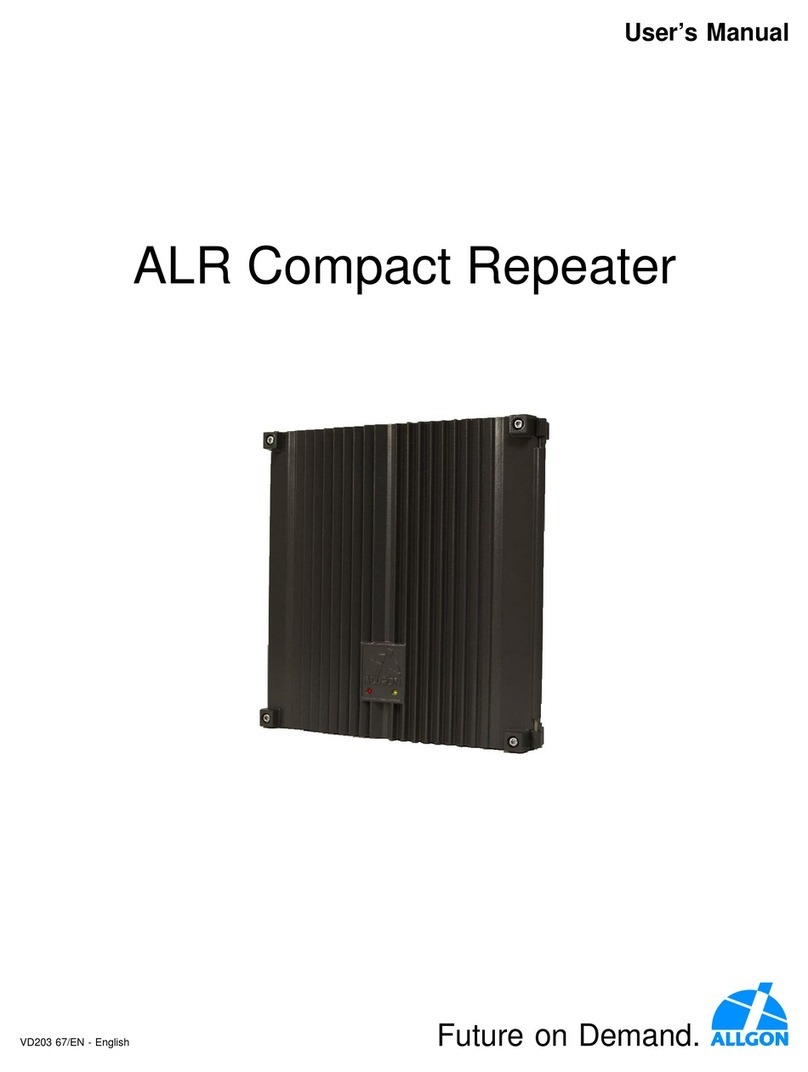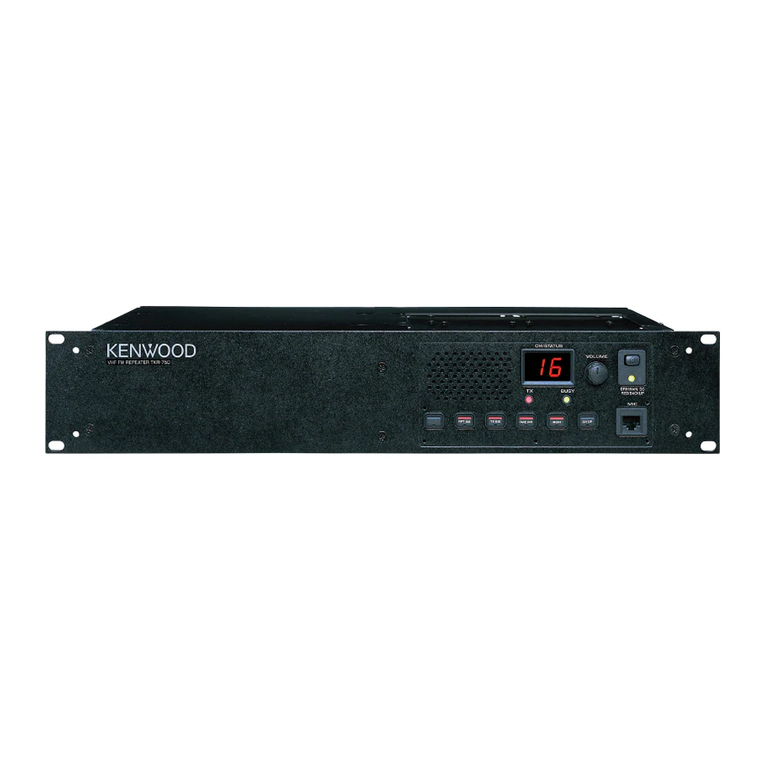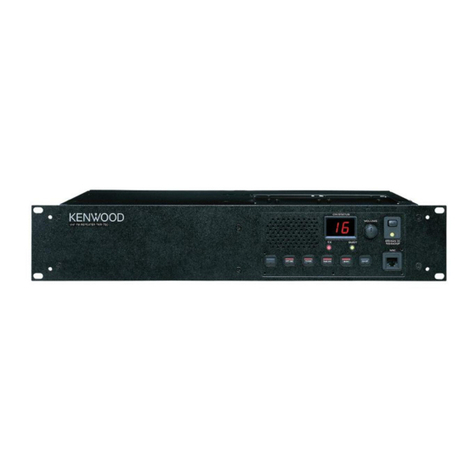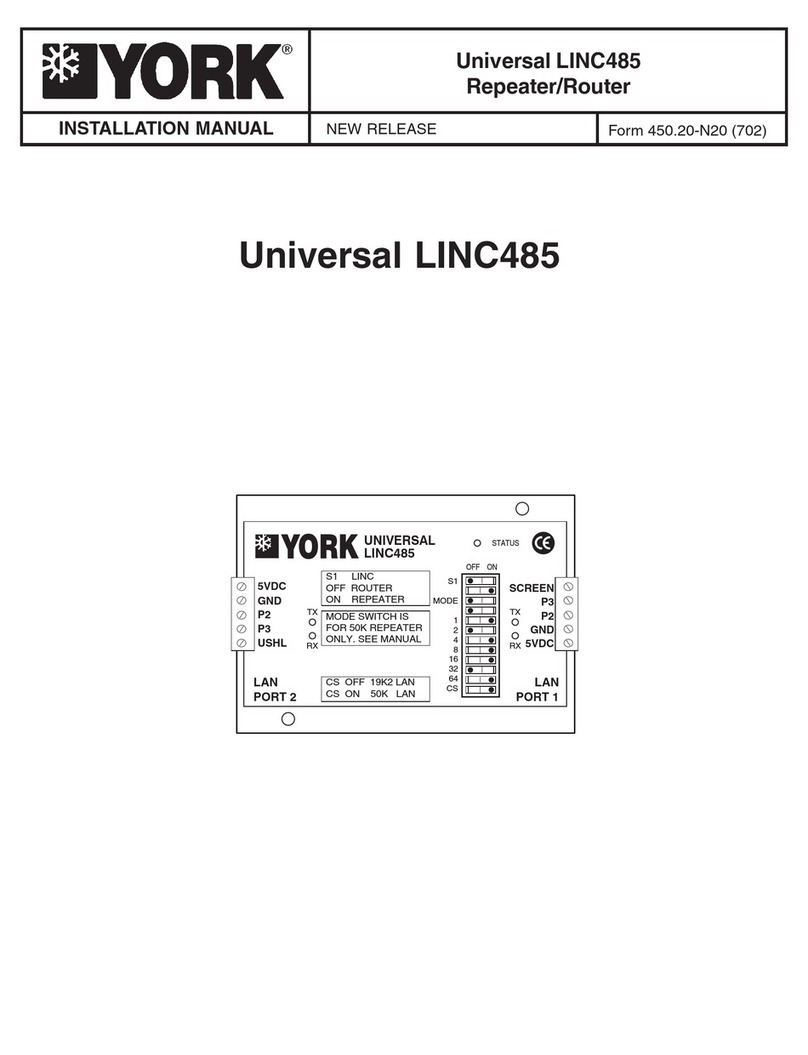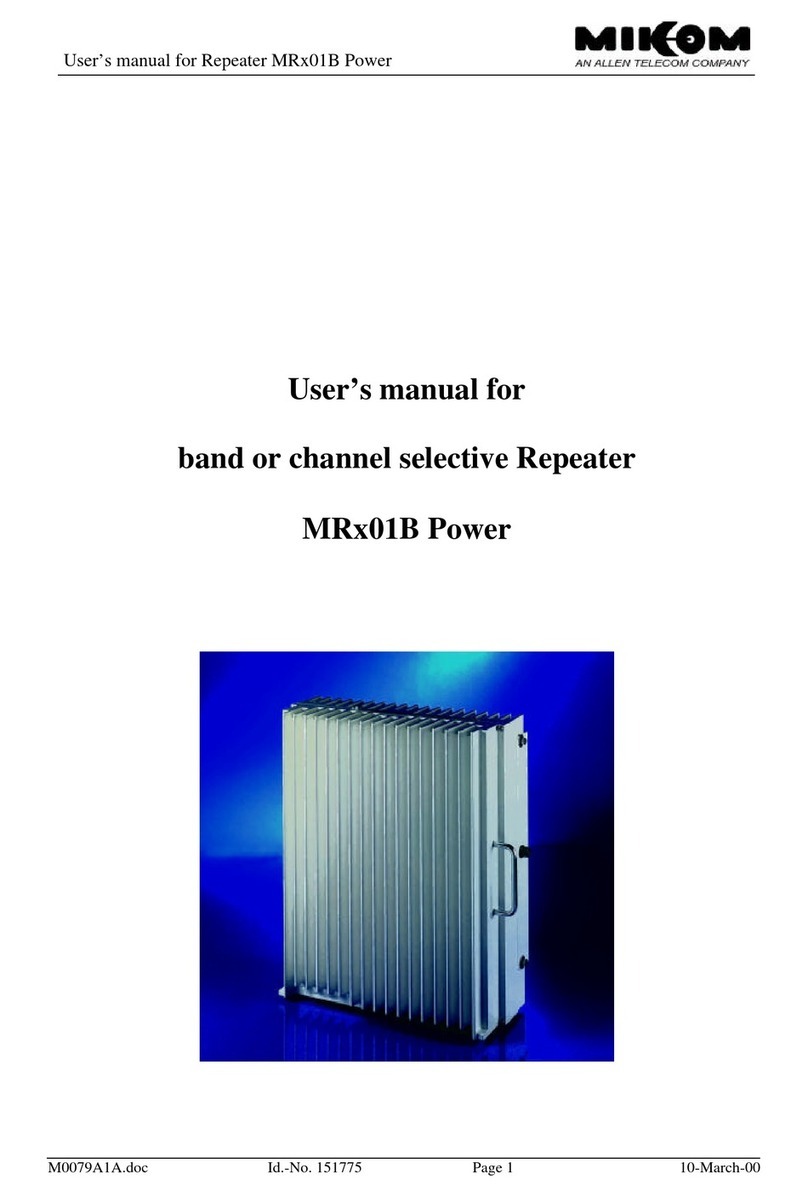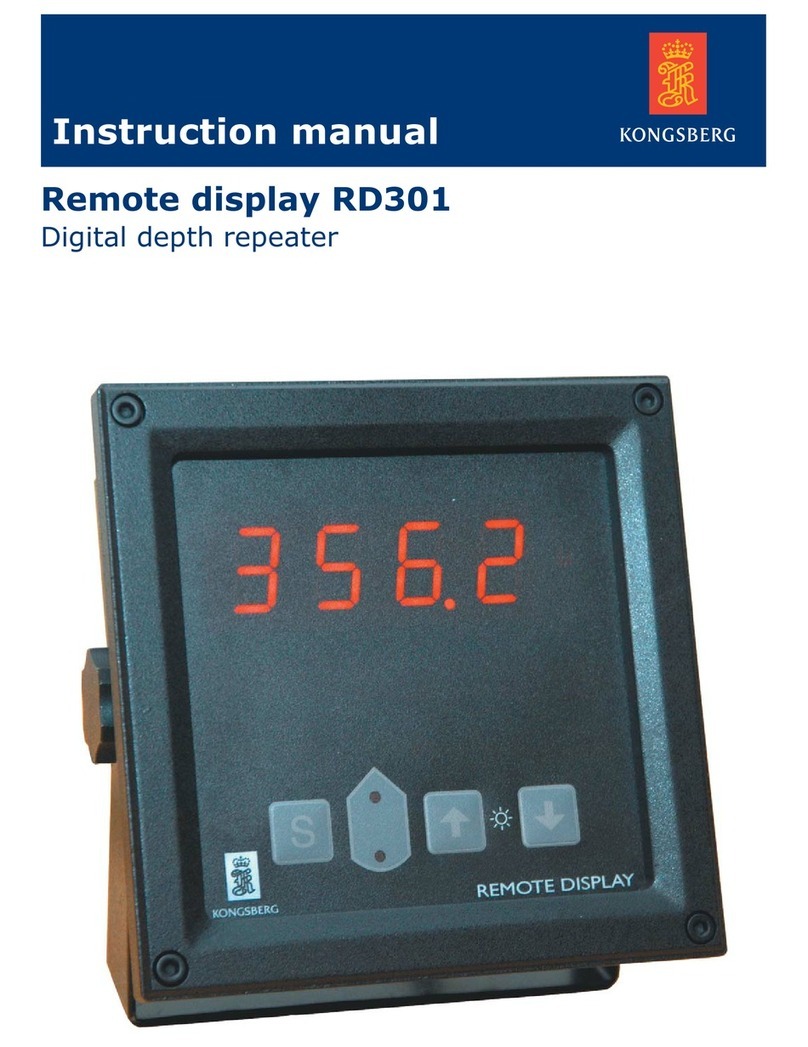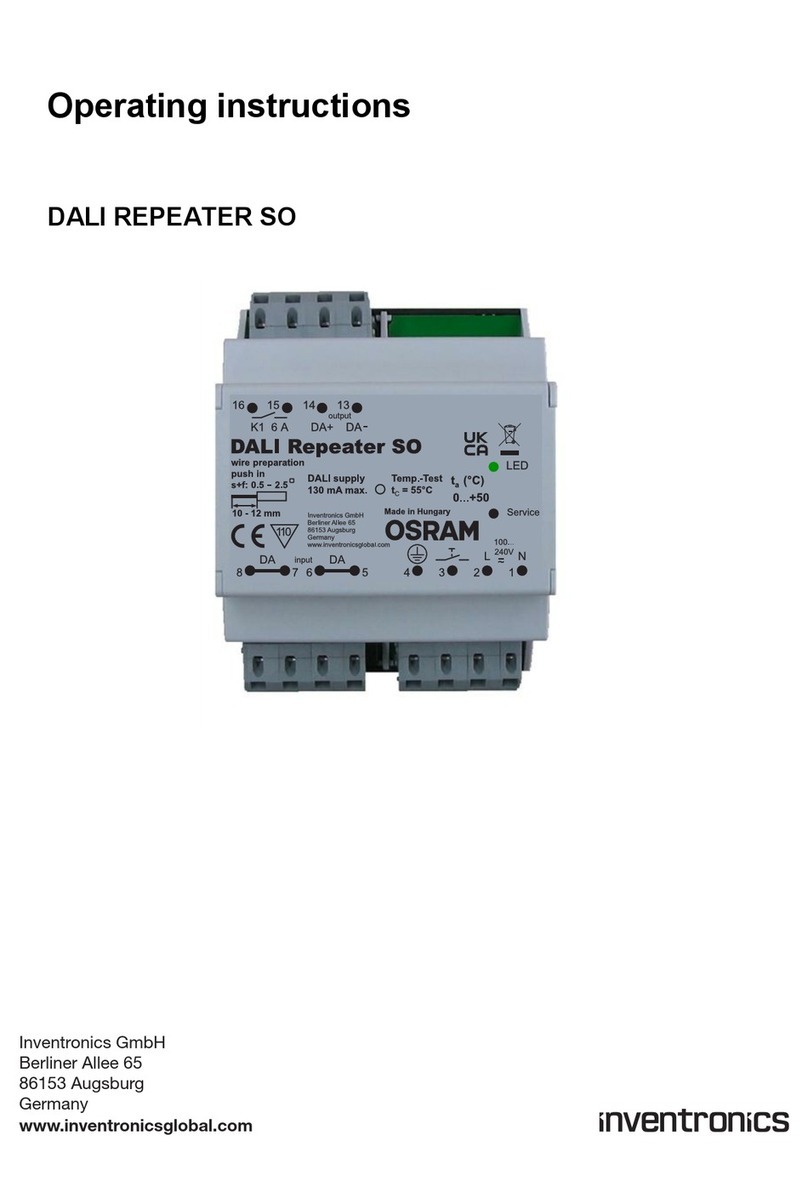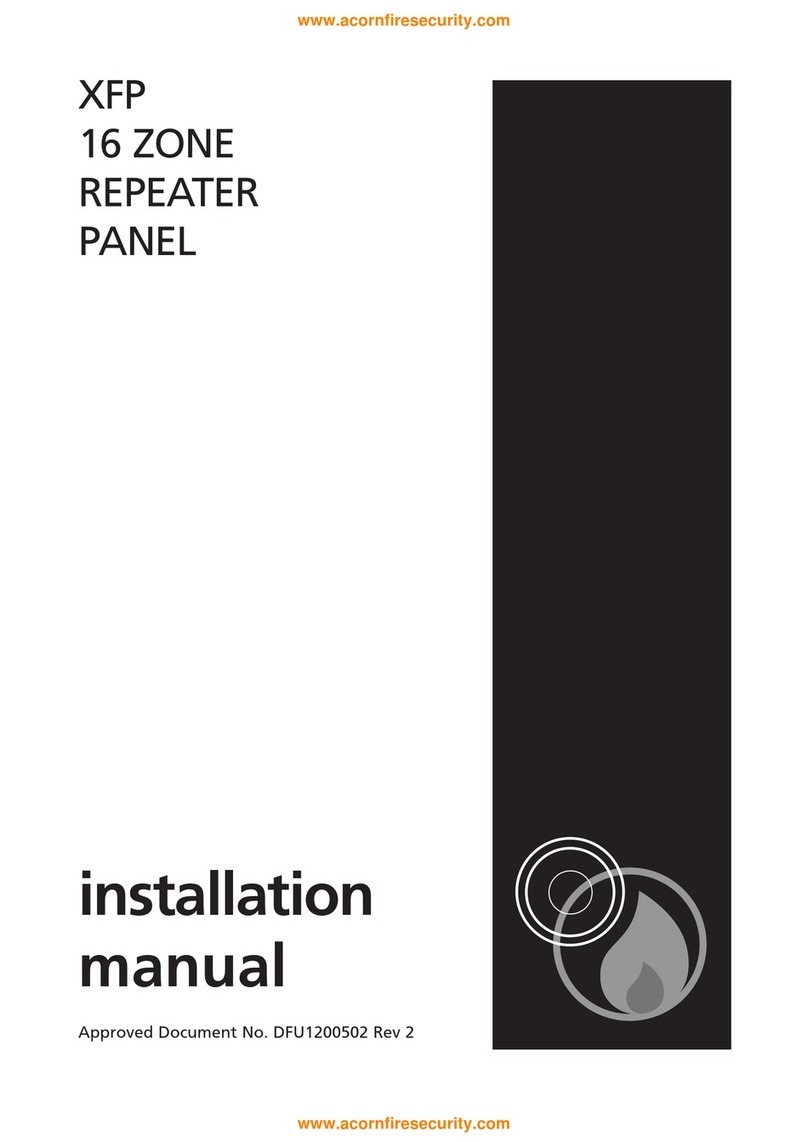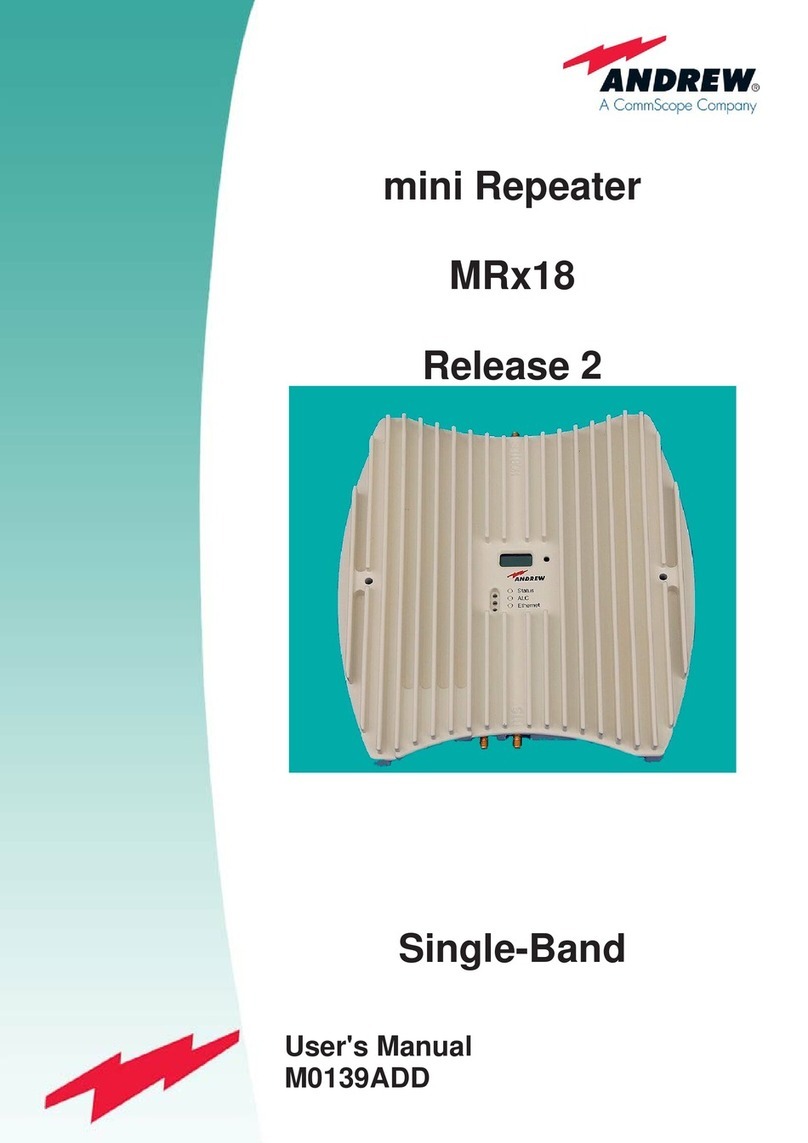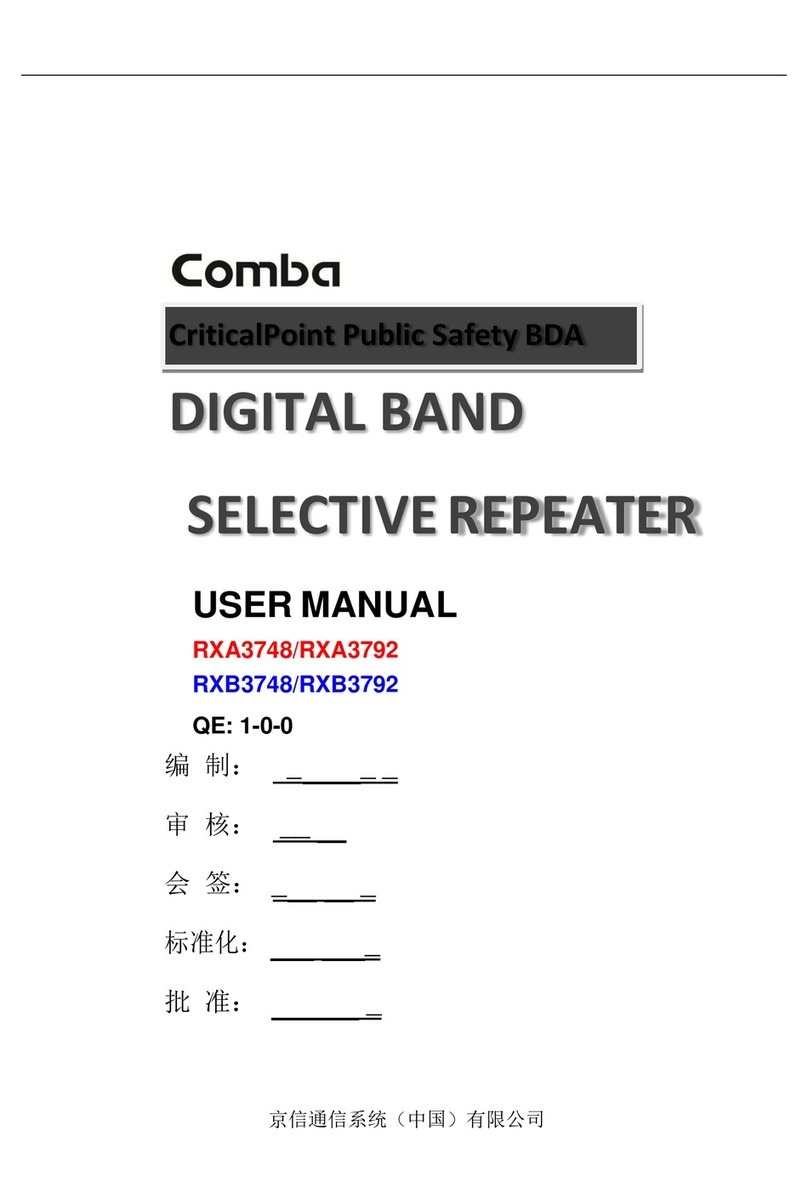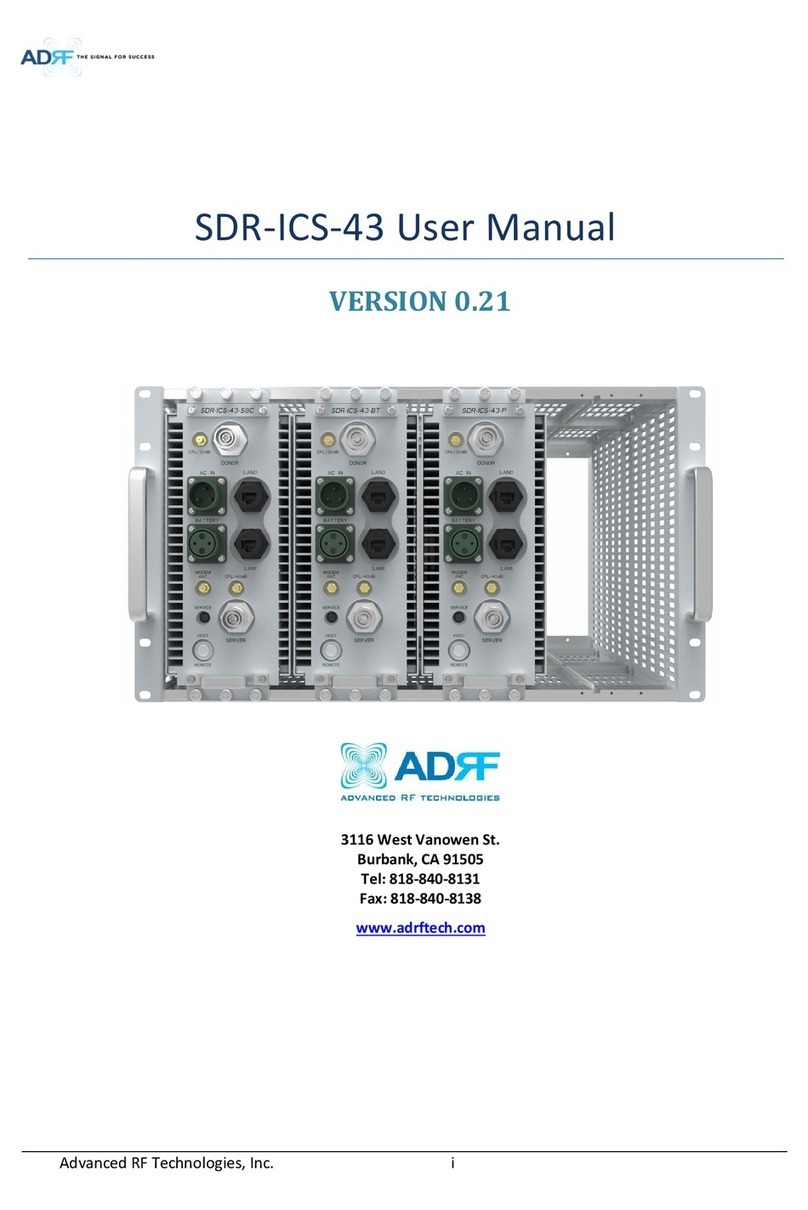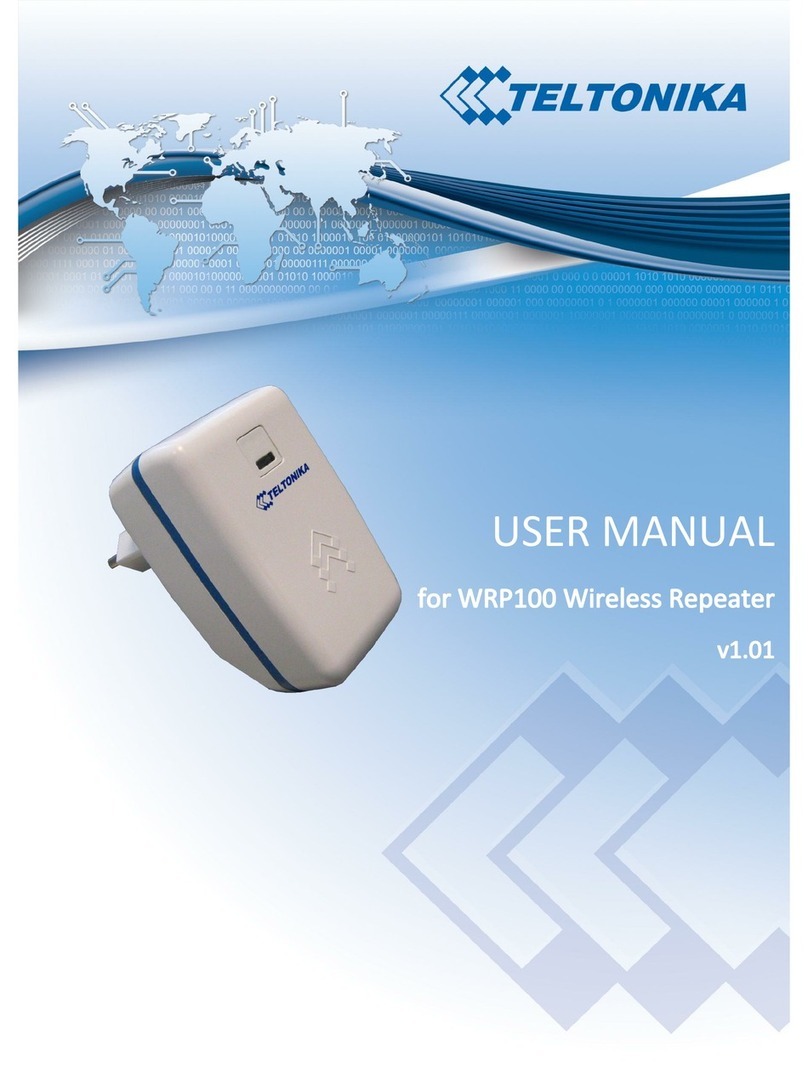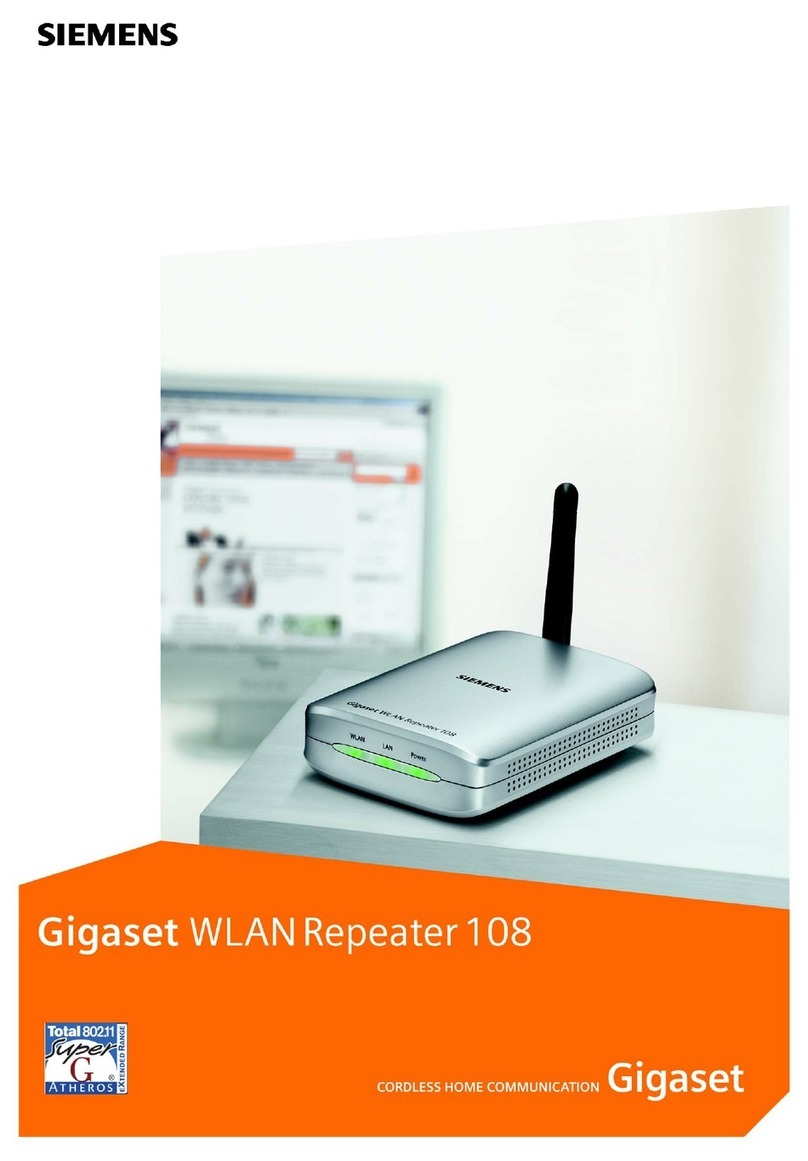Allgon AR User manual

User’s Manual
AR Repeaters
VD203 66/EN - English Future on Demand.

User’s Manual
AR Repeaters
Channel Selective and Band Selective Repeaters
–
English
Allgon Systems AB AR Repeaters
VD203 66/EN - User’s Manual Rev. P1A 2000-09 i

This document describes installation, commissioning and the design of the Allgon AR Repeaters.
Communication between Allgon AR repeaters and operators is carried out either by using Allgon OMT32 (Operation and
Maintenance Terminal), or Allgon OMS (Operation and Maintenance System). OMT32 is described in the OMT32, User’s
Manual. OMS is described in the Advanced Repeater OMS, User’s Manual.
Hardware and software mentioned in this document are subjected to continuous development and improvement.
Consequently, there may be minor discrepancies between the information in the document and the performance and
design of the product. Specifications, dimensions and other statements mentioned in this document are subject to change
without notice.
Allgon and its suppliers shall not be liable for any damages related to the software or hardware, or for any other damages whatsoever caused of the use of or
inability to use any Allgon product. This is applicable even if Allgon has been advised of the damage risk. Under any circumstances, Allgon’s entire liability
shall be limited to replace such defective software or hardware which was originally purchased from Allgon.
Teflon is a registered trademark of Du Pont. Other trademarks mentioned in this document are trademarks or registered trademarks of their respective
owners.
This document is produced by El, Tele & Maskin Ingenjörsfirma AB, Huddinge, Sweden.
Printed in Sweden.
Allgon Systems AB, SE-187 80 Täby, Sweden
Phone: +46 8 540 822 00 – Fax: +46 8 540 834 80 – Internet: www.allgon.com
This document or parts of it may not be reproduced without the written permission of Allgon Systems AB.
Infringements will be prosecuted. All rights reserved.
Copyright © Allgon Systems AB, Sweden, 1994-2000.
AR Repeaters Allgon Systems AB
ii Rev. P1A 2000-09 VD203 66/EN - User’s Manual

Contents
Abbreviations ............................................................................................................... vi
1. Safety ....................................................................................................................... 1-1
Warning Signs ..................................................................................................... 1-2
Static Electricity .................................................................................................. 1-2
2. Introduction ............................................................................................................. 2-1
Repeater Types .................................................................................................. 2-2
Using Repeaters ................................................................................................. 2-3
Shaded Area ................................................................................................. 2-4
Sports Arena ................................................................................................... 2-5
3. Installation ................................................................................................................ 3-1
Siting the Repeater ............................................................................................ 3-1
Sunshine ......................................................................................................... 3-1
Shelter ............................................................................................................. 3-1
Outdoor Installation and Service Limitations .............................................. 3-1
Dimensions and Weights ................................................................................... 3-2
Mounting ............................................................................................................. 3-4
Connection ........................................................................................................ 3-7
Connection Ports and Station Ground ............................................................ 3-10
Station Ground .............................................................................................. 3-10
P27 Auxiliary Port ........................................................................................... 3-11
P31 PC Port .................................................................................................... 3-11
P32 Modem Port ........................................................................................... 3-12
P33 Alarm Port ............................................................................................... 3-12
P34 Repeater to Repeater Link Port ............................................................ 3-14
Mains Breakdown Relay .................................................................................... 3-15
Installing 24 Volt or 48 Volt DC Power Supply Unit ......................................... 3-16
4. Commissioning ........................................................................................................ 4-1
Starting the Repeater ........................................................................................ 4-2
Indicators ....................................................................................................... 4-3
Measuring the Output Power Level .................................................................. 4-4
Voltage Supply Testpoints ................................................................................. 4-4
Repeater Configuration .................................................................................... 4-4
5. Functional Description ............................................................................................ 5-1
Repeater Design ................................................................................................ 5-2
Channel Selective GSM Repeater ............................................................... 5-4
Channel Selective CDMA Repeater ............................................................ 5-5
Channel Selective High Power CDMA Repeater ........................................ 5-6
Band Selective Repeater ............................................................................. 5-7
Combined Repeater .................................................................................... 5-8
Allgon Systems AB AR Repeaters
VD203 66/EN - User’s Manual Rev. P1A 2000-09 iii

Block Diagram .................................................................................................... 5-9
Downlink Signal Path ..................................................................................... 5-9
Uplink Signal Path .......................................................................................... 5-9
Channel Selective GSM Repeater ............................................................... 5-10
Channel Selective CDMA Repeater ............................................................ 5-12
Band Selective Repeater ............................................................................. 5-14
RCU ................................................................................................................. 5-15
R2R ................................................................................................................. 5-15
Alarm .............................................................................................................. 5-16
Repeater Setup ............................................................................................. 5-16
Board and Unit Descriptions ............................................................................. 5-17
DC - Directional Coupler .............................................................................. 5-17
DPX - Duplex Filter ......................................................................................... 5-18
LNA - Low Noise Amplifier ............................................................................. 5-19
CHA - Channel Amplifier Board for Channel Selective Operation .......... 5-20
CSA and PA Boards for Channel Selective CDMA Operation .................. 5-21
BSA and PA Boards for Band Selective Operation ..................................... 5-22
DIA Board ....................................................................................................... 5-23
CU Control Unit Board ................................................................................... 5-25
Repeater CU Software and Hardware Compatibility ................................. 5-26
Cabling ............................................................................................................... 5-27
Channel Selective GSM Repeater, 2 Channels ......................................... 5-28
Channel Selective GSM Repeater, 4 Channels ......................................... 5-29
Channel Selective CDMA Repeater ............................................................ 5-30
Channel Selective High Power CDMA Repeater ........................................ 5-31
Band Selective Repeater ............................................................................. 5-32
6. Optionals .................................................................................................................. 6-1
RCU, Remote Control Unit for GSM 900 .......................................................... 6-2
RCU, Remote Control Unit with PCMCIA Modem ........................................... 6-4
OMS, Operation and Maintenance System .................................................... 6-8
Traffic Statistics ................................................................................................... 6-8
Battery Backup ................................................................................................... 6-8
Fiber Optic Interface ......................................................................................... 6-8
7/16" Antenna Cable Connectors ................................................................... 6-8
R2R, Repeater To Repeater Link ....................................................................... 6-9
Requirements ................................................................................................. 6-9
Installation ...................................................................................................... 6-10
Configuration ................................................................................................. 6-10
7. Repeater Alarms ..................................................................................................... 7-1
Alarm Reference List ......................................................................................... 7-2
Index .............................................................................................................................. I-1
Questionnaire .............................................................................................................. Q-1
AR Repeaters Allgon Systems AB
iv Rev. P1A 2000-09 VD203 66/EN - User’s Manual
Table of contents
Other Allgon Repeater manuals
